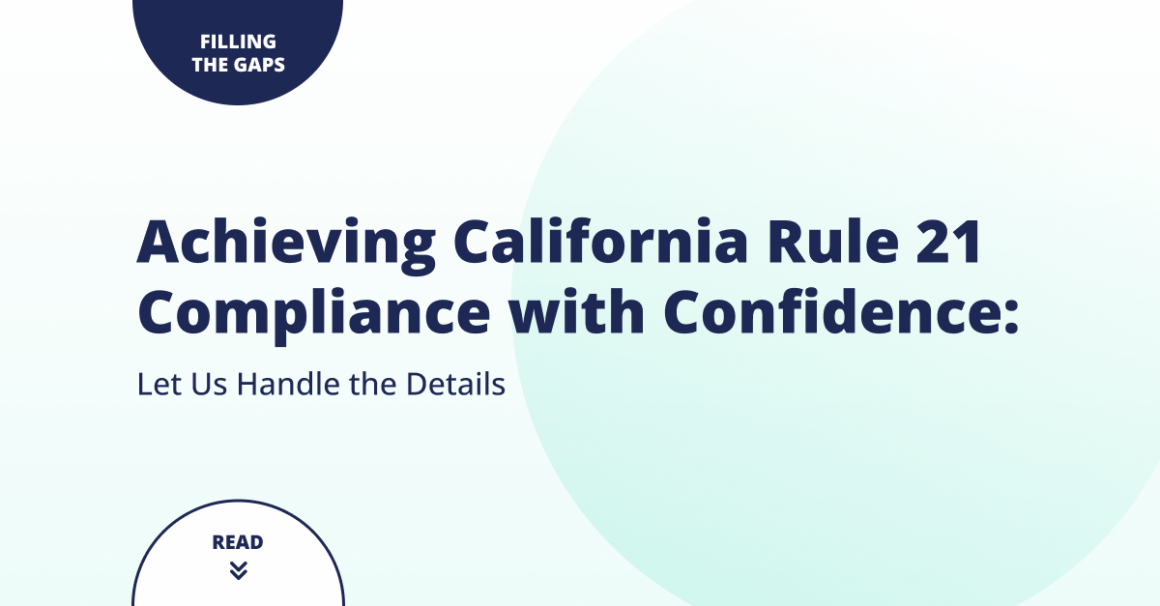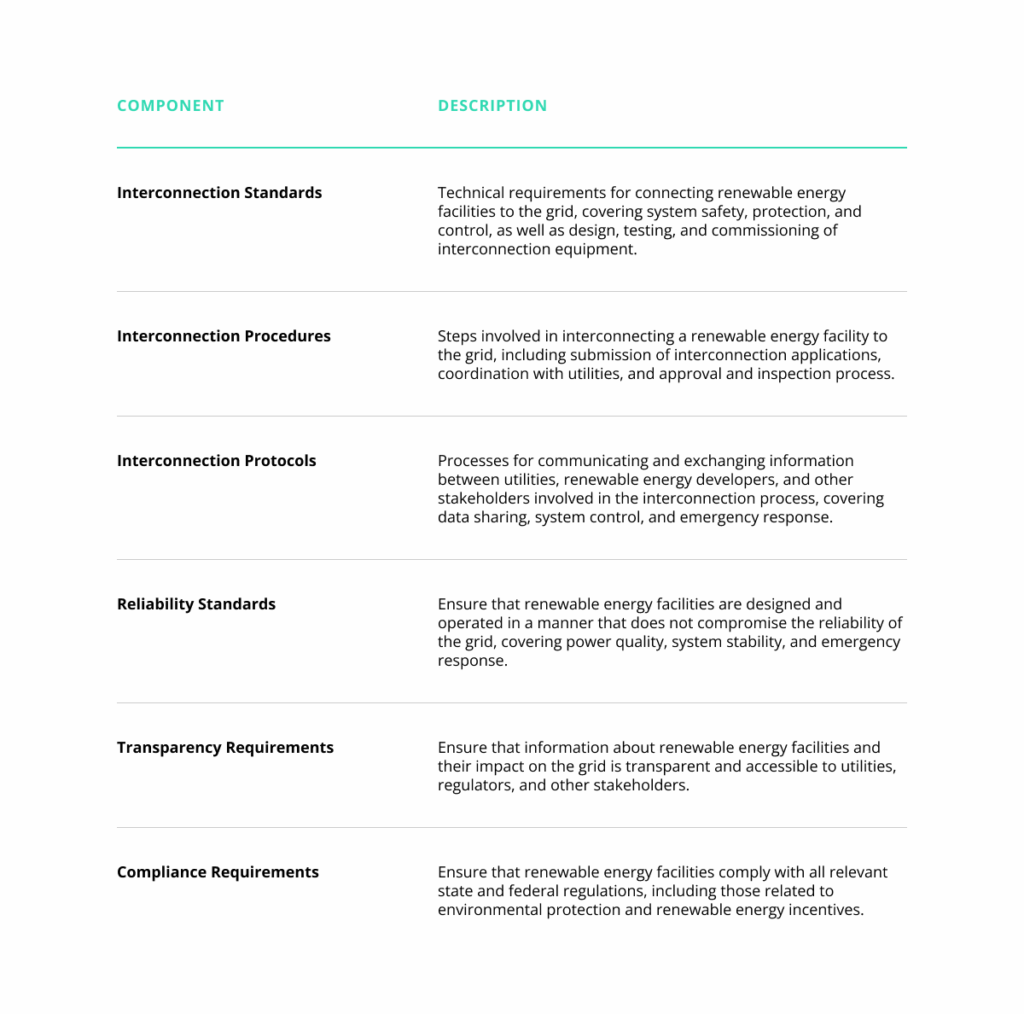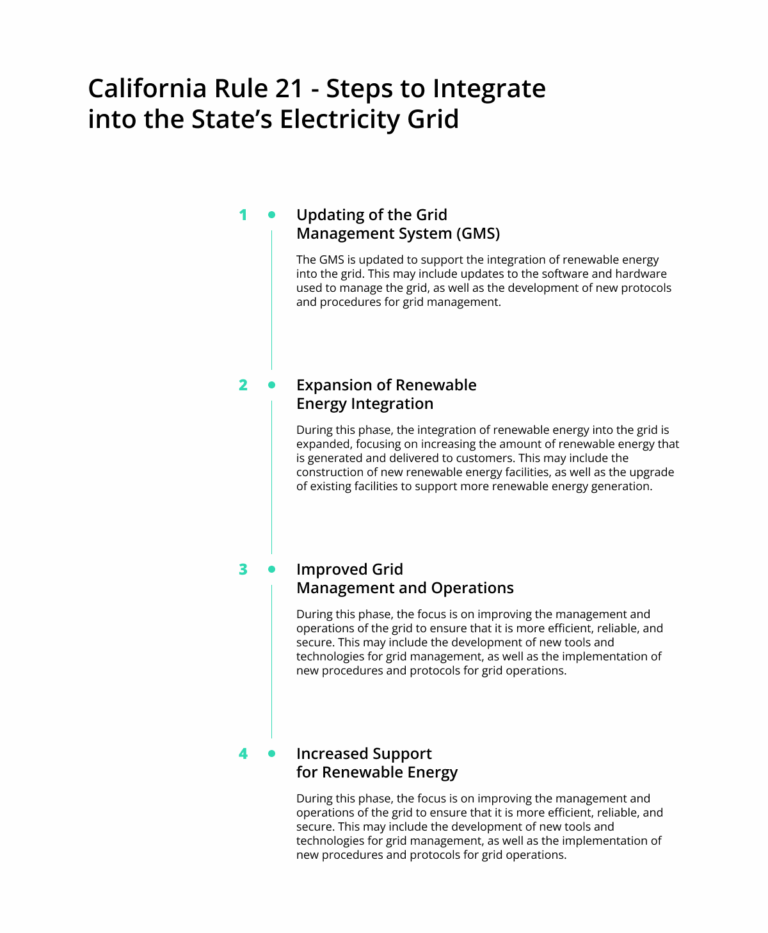Achieving California Rule 21 Compliance with Confidence: Let Us Handle the Details

Rule 21 – Reducing California’s Carbon Footprint
Rule 21 is an essential step towards California’s goal of reducing its carbon footprint and transitioning to a more sustainable energy future. It establishes a set of standards and procedures for interconnecting renewable energy facilities to the grid, as well as for transmitting and distributing renewable energy from these facilities. It also lays out the responsibilities of various stakeholders, including utilities, renewable energy developers, and grid operators.
All companies within the renewable energy industry must comply with the interconnection standards set forth in Rule 21, which outlines the technical requirements for connecting their facilities to the state’s electricity grid. What’s more, they must ensure that their facilities are designed and operated in a way that does not compromise the grid’s reliability.
Businesses must coordinate with utilities to ensure that their facilities are properly integrated into the grid and that any necessary upgrades are made to accommodate the increased renewable energy generation, and be transparent in their operations by providing information about their facilities and their impact on the grid to utilities, regulators, and other stakeholders.
To put it short – in order to be Rule 21 compliant, there are some standards and procedures to follow, protocols to implement, and requirements that have to be fulfilled:

California Rule 21 – Standards and Protocols
Anti-Islanding Protection
Anti-Islanding Protection is a safety measure used in the integration of renewable energy sources into the electricity grid. The purpose of anti-islanding protection is to ensure that the power produced by a renewable energy system is immediately disconnected from the grid if the grid goes down or experiences a fault, preventing the system from continuing to supply power to the grid and potentially endangering line workers or equipment.
In essence, anti-islanding protection ensures that a renewable energy system does not “island” or become disconnected from the grid while still supplying power, which could pose a safety risk to workers and equipment. The protection system typically monitors the grid voltage and frequency and immediately disconnects the renewable energy system if it detects deviations from normal operating conditions.
Low and High Voltage Ride-Through
Low Voltage Ride-Through (LVRT) and High Voltage Ride-Through (HVRT) are two important considerations for renewable energy systems integrated into the electricity grid.
LVRT refers to the ability of a renewable energy system to continue operating and supplying power to the grid during temporary low-voltage conditions. This is important because low voltage conditions can occur in the grid, for example, during a fault or a disturbance, and can cause renewable energy systems to shut down. By being able to continue operating during these conditions, LVRT helps to ensure grid stability and reliability.
HVRT, on the other hand, refers to the ability of a renewable energy system to withstand and continue operating during high voltage conditions, which can occur during a grid fault or during the reconnection of a faulted network. Also, HVRT helps to ensure that renewable energy systems do not contribute to further disturbances in the grid, and can help to maintain grid stability and reliability.
Low and High-Frequency Ride-Through
Low Voltage Ride-Through (LVRT) and High Voltage Ride-Through (HVRT) are both considered in California Rule 21 and protocols for integrating renewable energy into the state’s electricity grid.
In accordance with Rule 21, renewable energy systems must have the capability to continue operating during both low and high-voltage conditions to ensure grid stability and reliability. This requirement is known as LVRT and HVRT, respectively, and is an important consideration for renewable energy developers and utilities when connecting their systems to the grid.
Dynamic Volt-Var Operation
Dynamic Volt-Var Operation (DVVO) is a grid management technique used to optimize the voltage profile on the electricity grid. It involves the real-time control of both the voltage and reactive power in the grid and is used to improve grid efficiency, reliability, and stability.
In the context of renewable energy integration, DVVO can be used to ensure that renewable energy systems are integrated into the grid in a way that does not compromise the stability and reliability of the grid. This is particularly important in areas with high penetrations of renewable energy, where the variability of renewable energy sources can impact the voltage profile of the grid.
Ramp Rates
Ramp rates refer to the rate at which a renewable energy system can increase or decrease its output power. Ramp rates are an important consideration for integrating renewable energy into the electricity grid, as sudden changes in output power from renewable energy systems can impact grid stability and reliability.
Fixed Power Factor
Fixed Power Factor (FPF) refers to the power factor of a renewable energy system that is maintained at a fixed value, typically close to 1. The power factor is a measure of the ratio of real power (the power used to perform work) to apparent power (the total power flowing in the system) and is used to determine the efficiency of a system in converting real power to work.
Soft Start Reconnection
Soft Start Reconnection refers to a method used to reconnect a renewable energy system to the electricity grid after a fault or disconnection has occurred. In a soft start reconnection, the system is gradually brought back online in a controlled manner rather than being immediately reconnected at full power.
The purpose of a soft start reconnection is to minimize the impact of the reconnection on the electricity grid, reducing the risk of instability or voltage spikes that can occur when a large system is reconnected suddenly.
Soft start reconnection is considered part of these standards, and renewable energy systems must be designed to comply with the requirements for soft start reconnection as specified in Rule 21.
If you need help with implementing California Rule 21, reach out to us. As a trusted technological partner, we’d be happy to support your business in the process!
California Rule 21 – Steps to Integrate into the State’s Electricity Grid
1. Updating of the Grid Management System (GMS)
The GMS is updated to support the integration of renewable energy into the grid. This may include updates to the software and hardware used to manage the grid, as well as the development of new protocols and procedures for grid management.
2. Expansion of Renewable Energy Integration
During this phase, the integration of renewable energy into the grid is expanded, focusing on increasing the amount of renewable energy that is generated and delivered to customers. This may include the construction of new renewable energy facilities, as well as the upgrade of existing facilities to support more renewable energy generation.
3. Improved Grid Management and Operations
During this phase, the focus is on improving the management and operations of the grid to ensure that it is more efficient, reliable, and secure. This may include the development of new tools and technologies for grid management, as well as the implementation of new procedures and protocols for grid operations.
4. Increased Support for Renewable Energy
During this phase, the state of California may provide increased support for renewable energy, including financial incentives and other forms of support, to encourage more renewable energy development and integration.

contact us
Need expert guidance on your next energy project?
Reach out to us and discover how Codibly can offer tailored solutions to drive your business.